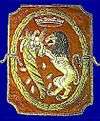Sezze
| Sezze | ||
|---|---|---|
| Comune | ||
| Comune di Sezze | ||
| ||
 Sezze Location of Sezze in Italy | ||
| Coordinates: 41°30′N 13°04′E / 41.500°N 13.067°E | ||
| Country | Italy | |
| Region | Lazio | |
| Province / Metropolitan city | Latina (LT) | |
| Frazioni | Casali, Ceriara, Colli, Crocemoschitto, Foresta, Sezze Scalo | |
| Government | ||
| • Mayor | Andrea Campoli (PD) | |
| Area | ||
| • Total | 101 km2 (39 sq mi) | |
| Elevation | 319 m (1,047 ft) | |
| Population (31 December 2015) | ||
| • Total | 24,894 | |
| • Density | 250/km2 (640/sq mi) | |
| Demonym(s) | Setini | |
| Time zone | CET (UTC+1) | |
| • Summer (DST) | CEST (UTC+2) | |
| Postal code | 04010, 04018 | |
| Dialing code | 0773 | |
| Patron saint | St. Charles of Sezze | |
| Website | Official website | |
Sezze (or Sezza) is a town, comune and former Latin Catholic bishopric in the Province of Latina, central Italy, about 65 kilometres (40 mi) south of Rome and 10 kilometres (6 mi) from the Mediterranean coast. The historical center of Sezze is located on a high hill commanding the Pontine plain.
The area has been famous for its fine climate since Roman times: warm and dry in summer, cool in winter.
History
According to a legend, the city was founded by the mythical hero Hercules,[1] after his victory over the Lestrigones, a population of giant cannibals living in southern Lazio. The town coat of arms features the white Nemean lion which Hercules slew in the first labor.
The historical Setia appeared around the 5th century BC as the Volscan settlement member of the Latin League. It became a Roman colony in 382 BC,[1] and flourished because of its strategic and commercial position near the "pedemontana" way and the Appian Way, the road that connected Rome to southern Italy.
During the Civil War between Gaius Marius and Sulla, Setia supported the former and was later punished by the victorious Sulla (82 BC). In the Imperial period Setia was famous for its villas, and its wines were praised by Martial, Juvenal and Cicero.
In the early Middle Ages the city had a troubled life due to its location near the main road of communication. But in 956 it was freed from the Papal authority and organized itself as a commune with laws of its own. Later, several popes sojourned in Sezze, including Gregory VII (1073), Paschal II (1116) and Lucius III (1182).
The semi-autonomous status lasted until the city, after decades of skirmishes and wars with neighboring Sermoneta and Priverno, was conquered by the troops of the Caetani family in 1381. After 12 years the Setini revolted and exterminated the occupiers and, once free, they returned under the protection of the Pope.
In 1656, after suffering the ravages of plague, and raids from Spanish and Austrian troops, the population was reduced by half.
In 1690 one of the first academies in Italy, the scientific-literary Academy of the "Abbozzati", was founded in Sezze.
In 1798 all of Lazio was occupied by French troops. The Setini rebelled, exterminating the garrison: they avoided a bitter revenge only by paying a large sum of money.
In the late 19th century the city was annexed to the newly formed Kingdom of Italy.
During World War II some churches and buildings in the historical center were destroyed by the American bombardments.
Main sights
Many of the original city walls still exist, built of large blocks of limestone in the polygonal style. This style is also seen in several terrace walls belonging to a later date, indicated by the careful jointing and bossing of the blocks of which they are composed. Such intentional archaism is by no means uncommon in the neighborhood of Rome.
The modern town, occupying the ancient site, is an episcopal see, with a much-restored 13th-century Gothic cathedral.
There are remains of Roman villas at the foot of the hill ('Monte Trevi') on which the town stands. The two terraces date to the end of the 2nd Century BC.[2]
Transportation
Sezze is connected to the railway line Rome–Naples. The main road connection is the modern SS7, which bears the name of the ancient Appian Way.
Twin towns
-
 Kozármisleny, Hungary, since 2004
Kozármisleny, Hungary, since 2004
References
- 1 2 Stillwell, Richard; MacDonald, William L.; Holland, Marian. "SETIA (Sezze) Italy.". perseus.tfts.edu (The Princeton Encyclopedia of Classical Sites). Retrieved 26 January 2016.
- ↑ Annalisa Marzano Roman Villas in Central Italy: A Social and Economic History , p. 455, at Google Books
Sources
![]() This article incorporates text from a publication now in the public domain: Chisholm, Hugh, ed. (1911). "article name needed". Encyclopædia Britannica (11th ed.). Cambridge University Press.
This article incorporates text from a publication now in the public domain: Chisholm, Hugh, ed. (1911). "article name needed". Encyclopædia Britannica (11th ed.). Cambridge University Press.
